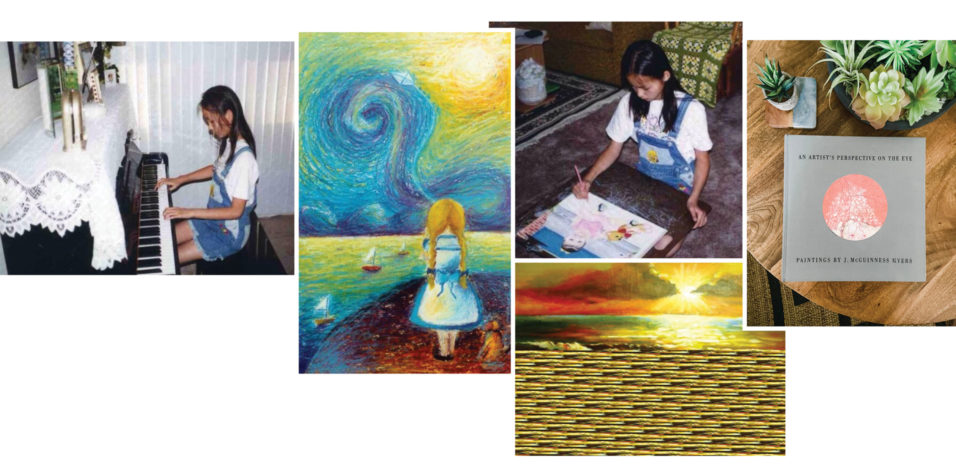
Splat! A jolt of electricity shot up my arm as my teacher firmly slapped the back of my wrist. I stopped; silence echoed through the room. I took a deep breath, raised my slouching wrists, and commanded my fingers to move again.
My classical piano teacher was frequently appalled by my poor form, and she was never afraid to show her disdain. She blamed it on the cheap, discount keyboard my mom bought for me at Costco when I was 7. As a single parent and working-class immigrant, my mom did her best to support my basic needs by working multiple part-time jobs waitressing in Chinese restaurants and housekeeping on nights and weekends. Because she couldn’t afford childcare, I remember being home alone often as a kid, but I developed an affinity for art and music in my free time. I scribbled drawings of Hello Kitty and Sailor Moon with colored pencils, designed jewelry, recorded mixtapes from the radio, and played simple tunes on the $2 recorder I received from my elementary school. It wasn’t until several years after attending nighttime bookkeeping and English classes that my mom was able to find a stable job and save enough money to pay for formal art and piano lessons for me. Little did I know that my journey into the arts would ultimately lead me to become an ophthalmologist.
AN EYE FOR THE ARTS
Piano. I had my first piano lesson when I was 11 years old, an age far greater than what is recommended for fostering musical ability. With only my happiness in mind, however, my mother scrounged up $5,000 to buy a secondhand upright Kawaii piano (Figure 1) to replace the worn-out keyboard on which I had taught myself to play. At my first lesson, my piano teacher chastised me for my clumsy hand posture, poor finger dexterity, and overall bad technique that, according to her, could not be undone. Tears pooled in my eyes as daggers of scorn emanated from hers. After the first day, I was ready to quit, but my mother would not let me. Of course, I did not fully appreciate my mother’s sacrifices to put me on that piano bench.
Surprisingly, over the next few weeks, my performance improved rapidly. I picked up new pieces and incorporated my teacher’s input with ease. Music theory came especially easily to me; I studied complex chord progressions and deconstructed music compositions through independent study with little to no instruction. Within 5 years, I had won several piano competitions and passed the highest level of the Certificate of Merit examination with honors, a feat that typically requires 10 years to achieve. Though less frequently and now occasionally followed by an approving smile, my piano teacher continued to admonish me when she felt I was relying on my “little smarts” (in Mandarin) instead of steadfast practice. She always let me know when I wasn’t living up to my fullest potential, and her voice follows me to this day, reminding me to do my best as a cataract and refractive surgeon.
Art. Various types of paper (lightweight to heavy), canvas (cotton vs linen), brushes (fan, flat, pointed), and paints (watercolor, acrylic, oil)—art supplies were expensive. Luckily, my art teacher gave many of her old supplies to me, and I was able to experiment freely (Figures 2–4). Oil pastel, watercolor, and acrylic paint became some of my favorite mediums. My mother was proud. When she bought our first home, she framed and hung all of my art pieces on her walls like it was a museum, and most of these pieces remain there to this day. My fascination with the basic elements of art—color, shadow, and contrast—built the foundation of my appreciation for vision and sight. From the rainbow hues of the iris to the bright glow of the retina, the eye is a work of art in and of itself. As Henry David Thoreau said, “The noblest feature, the eye, is the fairest-colored, the jewel of the body.”
Finding Ophthalmology
As a student at Harvard Medical School, I applied to ophthalmology after working with James Chodosh, MD, MPH, in his corneal immunology lab at Massachusetts Eye and Ear Infirmary.
During my residency, my program director at the University of Southern California, Vivek Patel, MD, PhD, gave me a book of eye illustrations entitled, An Artist’s Perspective on the Eye—Paintings by J. McGuinness Myers. The book was published by Bascom Palmer Eye Institute, where Mr. Myers worked as a medical illustrator from 1966 until his untimely death in 1968 and where I chose to complete my cornea and refractive fellowship. Mr. Myers beautifully and accurately illustrated the eye from the anterior to the posterior segment, including corneal pathologies via a 3D slit-view that could not be captured via traditional slit-lamp photography at that time. The book is a gift that I cherish, and it sits on my coffee table (Figure 5).
Although art was one of the first reasons I developed an interest in ophthalmology, it was my love of piano that probably sealed my fate as a cornea and anterior segment surgeon. While in the OR, I flash back to my piano lessons. Every delicate chop of a dense lens reminds me of the purposeful strike of a piano key. Every misthrow of a corneal suture evokes the same stomach-churning, disheartenment over a skipped note. As with the piano, learning intraocular surgery was a formidable task, but thanks to the guidance of mentors and dedicated practice, I now feel immense joy and satisfaction with each case I complete. I am grateful to have found the beauty and art of ophthalmology, a specialty that allows me to use my vision and hands together in a harmoniously meaningful way.




